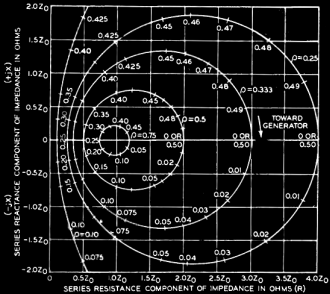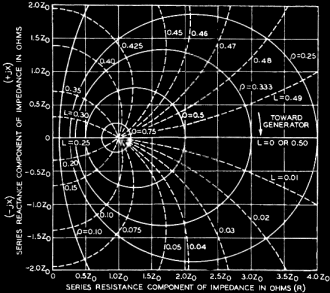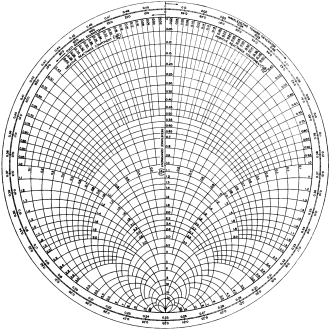Transmission Line Calculator
|
|
You might recognize the name Phillip H. Smith. He was an engineer at the Radio Development Department of Bell Telephone Laboratories. This January 1939 issue of Electronics magazine might be the first publication of what is now the most recognized form of his famous Smith Chart. Here, Mr. Smith describes the motivation behind his new chart and the process used to create it. Being a humble man (a presumption), he titled his invention the "Transmission Line Calculator," rather than naming it after himself. The Smith Chart enjoyed wide acceptance fairly quickly by those who understood how and why it worked. Analog Devices now owns the copyright to the Smith Chart; however, the company must not guard their ownership of its likeness too jealously since many thousands - probably hundreds of thousand or millions - of instances appear everywhere in print, online, and in software. Maybe some rambunctious lawyer will someday convince Analog Devices to collect royalties. If you hear of it in the works, be sure to buy ADI stock. The January 1944 issue of Electronics magazine carried a follow-on article by Mr. Smith entitled, "An Improved Transmission Line Calculator." This might be the first publication of what is now the most recognized form of his famous Smith Chart.Fig. 1 - Rectangular co-ordinate system forming the basis of the transmission line calculator. Resistance components plotted along abscissa, reactive components along the ordinates. Fig. 2 - Rectangular co-ordinate system similar to Fig. 1, but with dotted curves representing the locus of points at specified distances from the point of maximum impedance of the line. By Phillip H. Smith Radio Development Department Bell Telephone Laboratories Transmission line problems are greatly simplified if the line is terminated by an impedance equal to its characteristic impedance. Standing waves of current and voltage are then eliminated, and if losses are neglected, the input impedance, current, and voltage at all points along the line are constant. Computations for the current and voltage under these conditions are based simply on Ohm's law. In communication systems this special condition is usually considered most conducive to efficient trouble-free operation. There has long been a need for a simple means, without recourse to lengthy computations, for evaluating the impedance, current, and voltage at any chosen point along radio-frequency transmission lines in terms of specific values of the several transmission line parameters. This has led to the development of a special radio-frequency transmission-line calculator for solving many ordinary transmission-line problems. There are four factors that generally enter the solution of problems involving the changing input impedance along a line. These are the characteristic impedance of the line, the load impedance, the length of the line, and the input impedance. If any three of these are known, the fourth may be found from the relationship:
Where L is the length of the line in wavelengths, Z0 is its characteristic impedance, which for low-loss radio-frequency lines is essentially a pure resistance, Zr is the load impedance, and Zs is the input impedance. The independent variable Z0 will be a constant for any particular line, and consequently may conveniently be combined with Zs and Zr in the form of a ratio. With this transformation, the equation becomes:
For any one value of Zr/Z0 substituted in this equation a series of values for Zs/Z0 can be plotted for various values of L from zero up to one-half wavelength. Because L appears in the equation as an arc tangent, the curve will repeat itself for every half wavelength. If such a curve is plotted on a rectangular coordinate system with the resistance components along the abscissa axis and the reactance components along the ordinate axis, it will be found to be a circle with its center on the resistance axis. For other values of Zr/Z0 other curves could be drawn, and all would likewise be found to be circles with their centers on the resistance axis, but they would not be concentric. Such a set of curves is shown in Fig. 1. Each of these curves, however, represents more than a single value of Zr/Z0. At the load end of the line,. for example, where L = 0, Zs will be equal to Zr, which determines one point on the curve. Obviously every other point on the curve corresponds to another value of Zr, when L is taken as zero at that point. This other value of Zr, when substituted in the above equation, will give the same curve but with a different position for the point of L = 0. These curves, therefore, cannot be completely designated by a single value of Zr/Z0. It will be noted, however, that each curve gives a minimum and maximum value of Zs/Z0 which are the two points where the curve crosses the resistance axis. The ratio of the minimum to the maximum value of Zs/Zs, which is the same as the ratio of minimum to maximum Zs, is different for each curve, so that each may be designated by the ratio of minimum to maximum input impedance that is peculiar to it. Each circle thus represents the input impedance over a half wavelength section for a family of transmission lines of various values of characteristic and load impedances, but alike in having the same ratio of minimum to maximum impedance. The ratios of minimum to maximum current or voltage will also be the same for any transmission line represented by a single curve, and may be designated by ρ, and these values of ρ are marked on the curves. Fig. 3 - Circular form of transmission line calculator. The arm, shown below, is to be pivoted at the center of the circular chart. For convenience, a transparent slide may be slipped on the rotating arm. The points of minimum and maximum impedance on each curve are one-quarter wavelength apart, and all other points on the curves may be indicated as fractional wavelengths from the points of minimum or maximum impedance, as marked on the curves. If the points on the various curves at the same distance from the points of maximum impedance are connected by a line, the plot will appear as in Fig. 2. These distance curves are also circles; their centers are on the reactance axis and they intersect the original family of circles at right angles. Each of the these curves is marked with a value for L which represents the distance in wavelengths to the point of maximum impedance. Such a set of curves could be used to solve various transmission line problems. Assume, for example, that the resistance component of the load impedance was 2.7Z0 and the reactance component of the load impedance was -0.9Z0. This value of impedance is found to lie on the circle marked ρ = 0.333. The intersection at this point of the circle marked L= 0.02 simply indicates the distance to an arbitrary reference point where the impedance is maximum. This point on the curve actually represents the conditions at the load end of the line-where L. 0. The impedance at any other point, for example .08 wavelengths toward the generator, may be found by following clockwise around the circle marked ρ = 0.333 the required distance to the intersecting circle where L- (0.02 + 0.08), or 0.10. At this point the impedance will be found to be 0.8Z0 - j 1.0Z0. This information may be arranged in a much more convenient form, however, by a transformation of coordinates that converts the rectangular mesh of resistance and reactance coordinates into coordinates comprising two families of circles intersecting each other at right angles. If the curves of constant ρ, and constant L were plotted on these transformed coordinates, the ρ curves would be found to be concentric circles and the L curves would be equally spaced straight lines radiating from the center of the ρ circles. Instead of actually plotting the curves, however, an arm may be pivoted at the center of the ρ circles, and by providing a slide on this arm, any of the ρ circles may be described merely by rotating the arm with the slide fixed in the proper position. By the addition of an adjustable distance or L scale around the periphery, the impedance at any point along the line may be readily determined. A calculator of this type has been constructed to facilitate the solution of transmission -line problems, and is shown in Fig. 3. The resistance and reactance coordinates are marked as a ratio to Z0; thus a marking of 1.6 on a resistance circle means a resistance of 1.6 times Z0. The arm is graduated with a scale for p, and so the slide can be set to any desired value. The distance scale, which rotates around the periphery of the diagram, is marked from 0 to 0.5 wavelength by two scales reading in opposite direction, so that distance can be read in either direction from any initial starting point on the coordinate system. In using this calculator the length of the line and its characteristic impedance, Z0, will, for example, be known. If in addition both the resistance and reactance components of the impedance 30 at any point of the line are known, the values of the impedance at all other points, including the input impedance, and the location of the points of minimum and maximum impedance, current, or voltage, are readily found. Assume for example that the load impedance is known. The corresponding impedance point would be located on the coordinates of the calculator, and the arm and slide would be moved until the center line of the arm and the cross line of the slide intersected over this point. The ratio of minimum to maximum voltage, or current could then be read directly from the scales on the arm. The zero point of the outer distance scale would then be set under the center line of the arm, and the distance to the resistance axis of the calculator, corresponding to zero reactance, would then be the distance to the nearest point of minimum or maximum impedance. Here the impedance is a pure resistance, and the distance to this point is read on the distance scale in wavelengths. The value of this minimum or maximum resistance is determined by moving the arm to this position and reading the value under the line on the slide. The impedance at any other point, which might be the input end of the line, is found by moving the arm the required distance and reading under the intersection of slide and arm. If the distance were more than a half wavelength, one or more half wavelengths would, before moving the arm of the calculator, have to be subtracted from the total distance so that the remaining equivalent distance will be less than a half wavelength. At the load end of the line the impedance is Zr, and this same value of impedance will be found every half wavelength down the line as indicated in Fig. 4, where the successive points where Z = Zr are marked. Between any two such points there will be a point of minimum impedance, and one of maximum impedance. At these points the impedance is a pure resistance. These points, which are represented on the calculator by the transverse axis of zero reactance, are always a quarter wavelength apart. The distance between them and any other point may be read from the distance scale. For most radio frequency transmission lines where the insulating medium between conductors is chiefly air and the attenuation is negligible, the velocity of transmission is practically the same as that of light. The distance scale around the edge of the calculator is laid out in terms of wavelengths as measured on the transmission line. For transmission lines having considerable attenuation and especially those having an appreciable amount of high dielectric insulating material interposed between conductors, there may be a marked reduction in the velocity of transmission, and a correction factor must be applied to the distance scale. This correction is proportional to the reduction in the velocity of transmission which can be measured or computed from line constants. To extend the utility of the calculator to audio-frequency telephone lines or to other transmission lines, which may have an over-all attenuation up to 15 decibels, an attenuation scale expressed in 1 decibel intervals is provided along the adjustable arm. The zero point along this scale will be variable and consequently, the scale intervals are not numbered. For any particular problem, however, the zero point will be found where the sliding cross-hair on the arm intersects the scale when the slider is first adjusted to any known transmission line impedance. If the problem subsequently requires a movement of the rotatable arm along the distance scale "toward generator," the attenuation scale will extend from this zero point in the direction of the center of the calculator, or vice versa, as is indicated on the scale. It is necessary only to count off the required number of decibels along the scale. Moreover, if the input impedance at any two points along a transmission line is known, the attenuation of the line can be obtained directly from this scale. This will be indicated by the number of decibel intervals along this scale which the slider moves across when going from one impedance setting to the other. It should be noted, however, that for lines with reduced velocity and appreciable attenuation, the characteristic impedance Z0 may be complex, and the complex value should then be used to obtain the impedance quotients expressed as coordinates on the calculator.
Posted June 21, 2023 |
|






